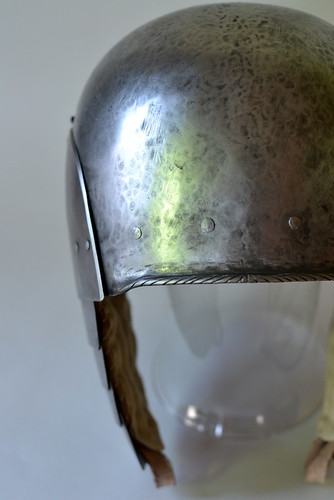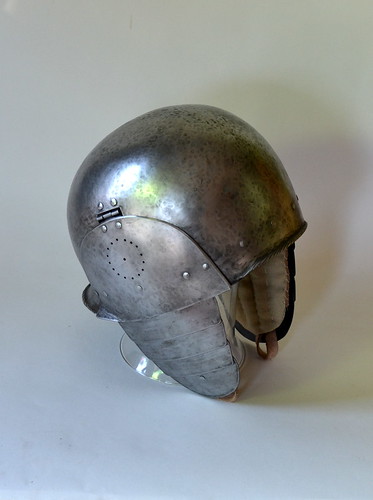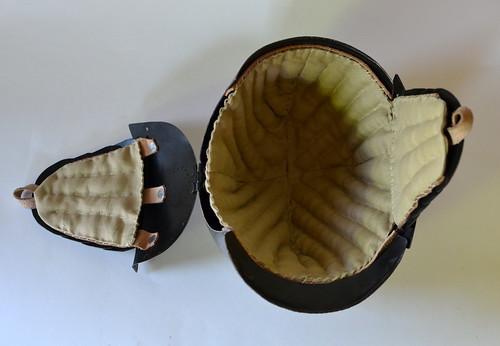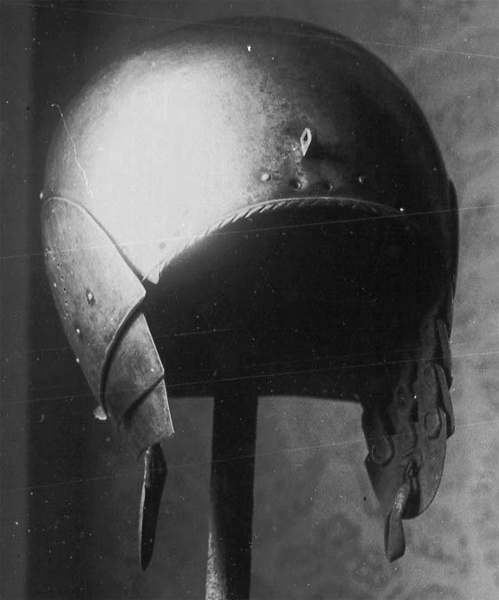| Author |
Message |
Jeffrey Hildebrandt
Industry Professional

|
 Posted: Fri 02 Jan, 2015 9:07 am Post subject: Early 16th C German infantry helmet repro - for sale Posted: Fri 02 Jan, 2015 9:07 am Post subject: Early 16th C German infantry helmet repro - for sale |
 |
|
Here is a non-commissioned project that I managed to finish over the holidays. It is a hardened steel infantry helmet with an adjustable, hand-stitched linen liner.
  
It is for sale, and should fit pretty much any head in the 22"-23" range. Finished weight is 1.5kg (3lb 6oz). I am asking CDN$800 for it, plus shipping.
More photos can be found on my FB page.
Thanks for looking.
-Jeffrey Hildebrandt
Royal Oak Armoury Website
Royal Oak Armoury Facebook
|
|
   |
 |
|
Mart Shearer
|
 Posted: Fri 02 Jan, 2015 11:21 am Post subject: Posted: Fri 02 Jan, 2015 11:21 am Post subject: |
 |
|
Good looking munitions piece!
For comparison, Sean Flynt had posted this example:

ferrum ferro acuitur et homo exacuit faciem amici sui
|
|
  |
 |
Jeffrey Hildebrandt
Industry Professional

|
 Posted: Fri 02 Jan, 2015 11:48 am Post subject: Posted: Fri 02 Jan, 2015 11:48 am Post subject: |
 |
|
Bingo! Thanks, Mart.
As you can see, the original has a staple of some sort on the brow, which was likely part of an adjustable nasal assembly. Not wanting to speculate about how it worked or what the other parts would have looked like, I chose to err on the side of caution and ignore it altogether.
Royal Oak Armoury Website
Royal Oak Armoury Facebook
|
|
   |
 |
|
Mart Shearer
|
 Posted: Fri 02 Jan, 2015 2:23 pm Post subject: Posted: Fri 02 Jan, 2015 2:23 pm Post subject: |
 |
|
A nasal probably wouldn't have been far different from the one you did on the triple-combed sturmhaube, but the helm looks fine without one as well. I suspect the two holes nearest the brim would have held a bracket, while the vertically aligned piece held the screw to set the bar? Or maybe not. A wise decision to not speculate, then.
ferrum ferro acuitur et homo exacuit faciem amici sui
|
|
  |
 |
Jeffrey Hildebrandt
Industry Professional

|
 Posted: Fri 02 Jan, 2015 4:43 pm Post subject: Posted: Fri 02 Jan, 2015 4:43 pm Post subject: |
 |
|
I thought that the pairs holes at the front of the helmet might have held a staple of some sort, too, until I noticed that the helmet has quite a few pairs of holes around the other margins. The holes at the front may have just served for attaching a fabric cover, along with the rest of them.
The staple/tab at the front may have secured a nasal with a slot down its centre, which could have been tightened in place with a wedge in the slot of the staple. I haven't seen anything like that on an extant helmet, though. Another idea would be that the staple is actually a turning pin, and the shank it pivots on is oblong, so that it would lock into notches in the slot of the nasal, like on contemporary Turkish helmets, in which case the pair of holes below would be required to hold a guide to keep the nasal vertical.
I could get carried away speculating, though, so you can see why I just left it out!
Royal Oak Armoury Website
Royal Oak Armoury Facebook
|
|
   |
 |
|
|

